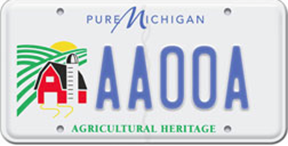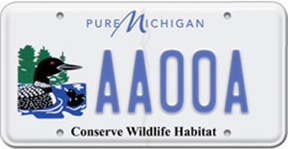By JENNA CHAPMAN
Capital News Service
LANSING – All Great Lakes drivers have something in common: They can buy license plates that benefit the environment.
The causes are as diverse as protecting water, funding nature preserves and saving river otters. Michigan offers 27 plates, including four focusing on the environment and one for lighthouse preservation. That number pales in comparison to Ohio where 164 specialty plates are available, including two that benefit Lake Erie projects.
All that variety has drawbacks for some environmental causes, and the increasing competition for specialty plate sales means fewer drivers are buying environmental plates.

The Agricultural Heritage plate supports agricultural education in schools. Image: Credit: Michigan Secretary of State.
Michigan offers a Wildlife Habitat plate that funds the Department of Natural Resources’ Nongame Fish and Wildlife Trust Fund. Sales have remained constant, according to Dan Kennedy, the endangered species coordinator of the DNR’s Wildlife Division.
In the 2013-14 fiscal year, the Wildlife Habitat plates produced $234,370 in revenue, compared to $238,960 five years ago. There are 21,802 Wildlife Habitat plates in circulation.
Michigan also offers an Agriculture Heritage plate, which raises money for agriculture educational programs for grades K-12. There are 5,849 of them on the roads. They raised $66,260 in 2013-14.
The Water Quality plate produced $234,370 during the same year. There are 21,802 plates in circulation, according to the Secretary of State’s office. The revenue supports water projects such as real-time beach monitoring and the Michigan Volunteer River, Stream and Creek Cleanup Program.
“All the money we raise is passed directly to local projects,” said Lois Marinangeli, the Department of Environmental Quality’s Water Resource Division’s finance chief.
In September 2014, Michigan released a Ducks Unlimited plate to benefit the organization that aims to conserve and promote waterfowl habitat.
The environmental plates are among 27 fund-raising specialty plates available in Michigan, including 15 public university plates and others that benefit causes such as the Children’s Trust Fund and Boy Scouts.
When a specialty plate is issued, the motorist pays $35 more than the standard registration fee, with $25 going to the special cause or university. Annual renewals cost $10 more than the standard registration fee, with the chosen cause getting the full $10.
In Ohio, drivers can choose from two Lake Erie license plate designs, one with a lighthouse and another with a life preserver. Together they raise about $200,000 a year for the Ohio Lake Erie Commission, which uses the money for projects that benefit Lake Erie.
Rian Sallee, the commission’s environmental specialist and grants coordinator, said the recent increase of other specialty plates has reduced sales of Lake Erie plates by 6 to 10 percent since 1997.

The Wildlife Habitat plate supports protection of non-game wildlife and habitat. Credit: Michigan Secretary of State.
And commission Executive Director Gail Hesse said, “There are so many different plates, it is hard to differentiate ourselves.”
Indiana offers a plate to support the Indiana Heritage Trust Fund, an organization that buys land for state parks and nature preserves.
Wisconsin’s Endangered Resource plates help protect and manage rare and non-game species.
Jenna Chapman writes for Great Lakes Echo.